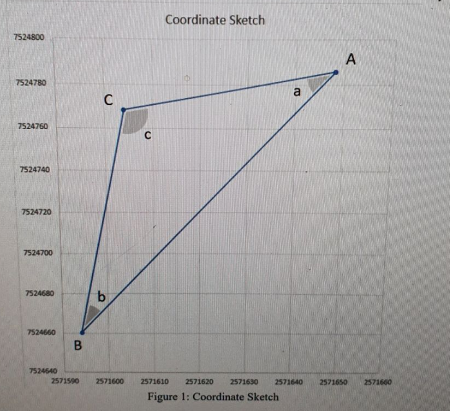6) Calculate the internal horizontal angles a, b, and c as shown in Figure 1 and present them in DMS, Decimal Degrees, and Radians.
6) Calculate the internal horizontal angles a, b, and c as shown in Figure 1 and present them in DMS, Decimal Degrees, and Radians.
Advanced Engineering Mathematics
10th Edition
ISBN:9780470458365
Author:Erwin Kreyszig
Publisher:Erwin Kreyszig
Chapter2: Second-order Linear Odes
Section: Chapter Questions
Problem 1RQ
Related questions
Question
Solve only q6

Transcribed Image Text:Table 1: Coordinate Values
A
B
C
7524800
7524780
7524760
7524740
7524720
7524700
7524680
7524660
7524640
B
2571590
C
b
N (m)
7524785.964
7524660.418
7524768.416
2571600
C
E (m)
2571648.112
2571594.148
2571603.989
Coordinate Sketch
2571610
2571620 2571630
a
2571640
Figure 1: Coordinate Sketch
A
2571650
H (m)
21.455
53.798
39.671
2571660

Transcribed Image Text:Using the coordinates for points A, B, and C provided in Table 1 and plotted in Figure 1, answer
the following questions:
1) What type of coordinate system is being used here? Be as specific as possible.
2) Compare and contrast 3D and 1+2D coordinate systems. Is there any way to distinguish
which type these are (3D or 1+2D) with the information provided?
3) Explain the concept of the planar approximation. Can we safely make use of the planar
approximation in this case? Validate your answer with numerical proof.
4) Calculate the following azimuths and present them in DMS (rounded to the nearest
arcsecond):
X BA; a BC, aAC, O CA
5) Calculate the following slope distances (hint: the distance equation shown in lecture
slides is for the 2D case!):
SAB SBC SCA
6) Calculate the internal horizontal angles a, b, and c as shown in Figure I and present
them in DMS Decimal Degrees, and Radians.
Expert Solution
Step 1
Given

and

Step by step
Solved in 4 steps with 2 images

Recommended textbooks for you

Advanced Engineering Mathematics
Advanced Math
ISBN:
9780470458365
Author:
Erwin Kreyszig
Publisher:
Wiley, John & Sons, Incorporated

Numerical Methods for Engineers
Advanced Math
ISBN:
9780073397924
Author:
Steven C. Chapra Dr., Raymond P. Canale
Publisher:
McGraw-Hill Education

Introductory Mathematics for Engineering Applicat…
Advanced Math
ISBN:
9781118141809
Author:
Nathan Klingbeil
Publisher:
WILEY

Advanced Engineering Mathematics
Advanced Math
ISBN:
9780470458365
Author:
Erwin Kreyszig
Publisher:
Wiley, John & Sons, Incorporated

Numerical Methods for Engineers
Advanced Math
ISBN:
9780073397924
Author:
Steven C. Chapra Dr., Raymond P. Canale
Publisher:
McGraw-Hill Education

Introductory Mathematics for Engineering Applicat…
Advanced Math
ISBN:
9781118141809
Author:
Nathan Klingbeil
Publisher:
WILEY

Mathematics For Machine Technology
Advanced Math
ISBN:
9781337798310
Author:
Peterson, John.
Publisher:
Cengage Learning,

